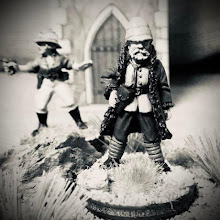Infantry
units for the 18th century represent Infantry Regiments; Infantry units
in the 19th century represent Brigades and are on bigger stands. For
both centuries, Cavalry are Brigades.
Unlike
other rules where players have to worry about the formations of their
individual units, in these rules it is assumed that the Brigadiers and
Colonels know their business and will deploy their units accordingly. In
this game players need to worry about deploying and maneuvering their
armies!
As
mentioned, a roster sheet (posted in an earlier blog) is used to keep
track of the status of units. Each "strength" point of infantry or
cavalry represents approximately 500 men. Each strength point of
artillery represents 6 guns. Most units for the War of Spanish
Succession have 2 strength points each. Units lose points through long
range fire and close combat (which represents close range musketry and
melee combined).
Morale,
command and division cohesion are all elements of the game but not
overly complicated. In fact, the basic rules are just 18 pages long!
Now, on to battle!
The lovely city of Oberbratwurst at the peak of the tourist season.
Imperial cavalry on the Allied Left Flank commanded by the Austrian Lieutenant General von Natzmer.
.JPG)
The Danish contingent of the Imperial Infantry Corps under the command of the Prince of Anhalt-Dessau.
The Danish Foot Guards (Yes I painted them because they had yellow coats!)
Major General the Prince of Holstein-Beck's Infantry Command consisting of Dutch, Scottish and English troops.
Lieutenant General Lord John Cutts leads his wing of Allied infantry.
.JPG)
Allied Cavalry commanded by General of Horse the Erbprinz of Hesse-Kessel move to the extreme left flank of the Allied line.
.JPG)
The Elite French Gendarmes take the position of honor as part of the Comte de Zurlauben's forces.
The Garde Francaise are held in Army reserve.
The Bavarian Leibregiment in the middle of the Franco-Bavarian deployment. The Marquis de Maffei commands the Bavarian infantry.
More of the Bavarians under the Marquis de Maffei.
.JPG)
Massed French and Bavarian Cavalry under the Count d'Arco support a French infantry line.

Turn
1: Franco-Bavarians. We diced to see who would go first and the
Franco-Bavarian Army won the toss. I immediately saddled my horse and
pointed at the enemy line. "Advance!" I said. I decided to move and take
control of the center of the battlefield, hoping to throw my opponent
off by my aggressive move. I had a regiment of dismounted dragoons move
into Oberbratwurst and ease the concerns of the inhabitants of the
lovely Bavarian city.

Situation Map After the Franco - Bavarian Advance

The might of the French and Bavarian Armies


The
French and Bavarians quickly seize control of the center of the
battlefield while the French cavalry on the right flank move around the
outskirts of Oberbratwurst in an attempt to deploy into line of battle.
 Dismounted
French Dragoons occupy Oberbratwurst. The yellow marker behind them
signifies that the dragoons are disorganized. In other words, they lost
their "battle formation" as they moved through the streets and will need
some time to reorganize.
Dismounted
French Dragoons occupy Oberbratwurst. The yellow marker behind them
signifies that the dragoons are disorganized. In other words, they lost
their "battle formation" as they moved through the streets and will need
some time to reorganize.Turn 1: The Grand Alliance. So did my advance through off the Allies? Nope. In a surprise move (at least it was a surprise to me!), it seemed like every horseman in the Allied army was bearing down on the Franco-Bavarian left flank. Then I thought - wait a minute, I outnumber him in cavalry about 2 to 1 (BWAH HAH HAH!).

 The
Austrian Cuirassier units boldly charge into the French cavalry. The
line behind the French consists of Bavarian Cuirassiers and more French
Cavalry.
The
Austrian Cuirassier units boldly charge into the French cavalry. The
line behind the French consists of Bavarian Cuirassiers and more French
Cavalry.
French
and Austrian Infantry prepare to blast away at each others lines. The
Danish Corps and the Bavarians will also exchange fire as both sides
have light losses.

And
then it got ugly. The French cavalry forgot that they outnumbered their
Austrian counterparts. The furious and unexpected charge of the
Austrian Cuirassiers disordered and swept from the field the majority of
the French Cavalry . . .
 The French Cavalry Commander, the Count d'Arco, boldly stares down the Austrians as he wonders where his cavalry command went.
The French Cavalry Commander, the Count d'Arco, boldly stares down the Austrians as he wonders where his cavalry command went.Next: The Franco - Bavarian Response.


.JPG)
.JPG)
.JPG)
.JPG)





Impressive and spectacular!
ReplyDeleteThanks Phil.
Delete